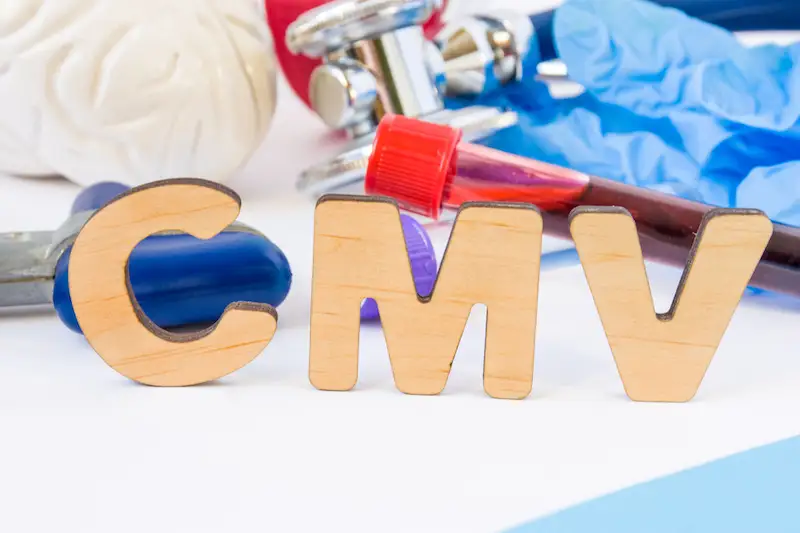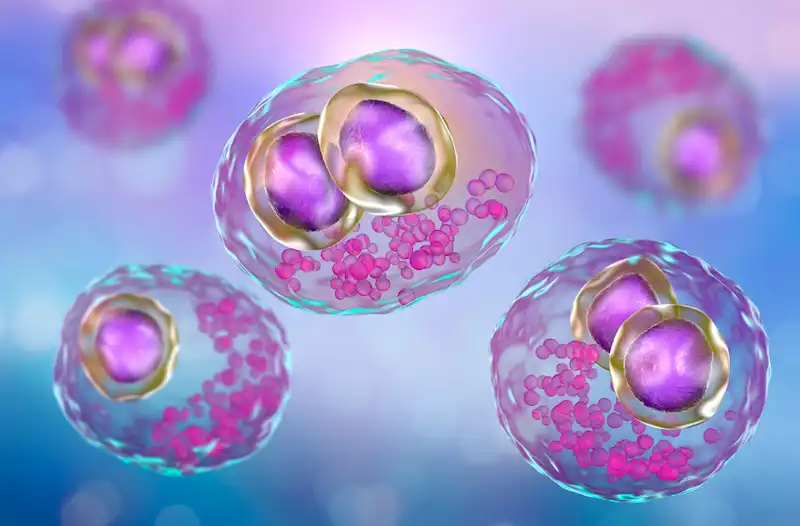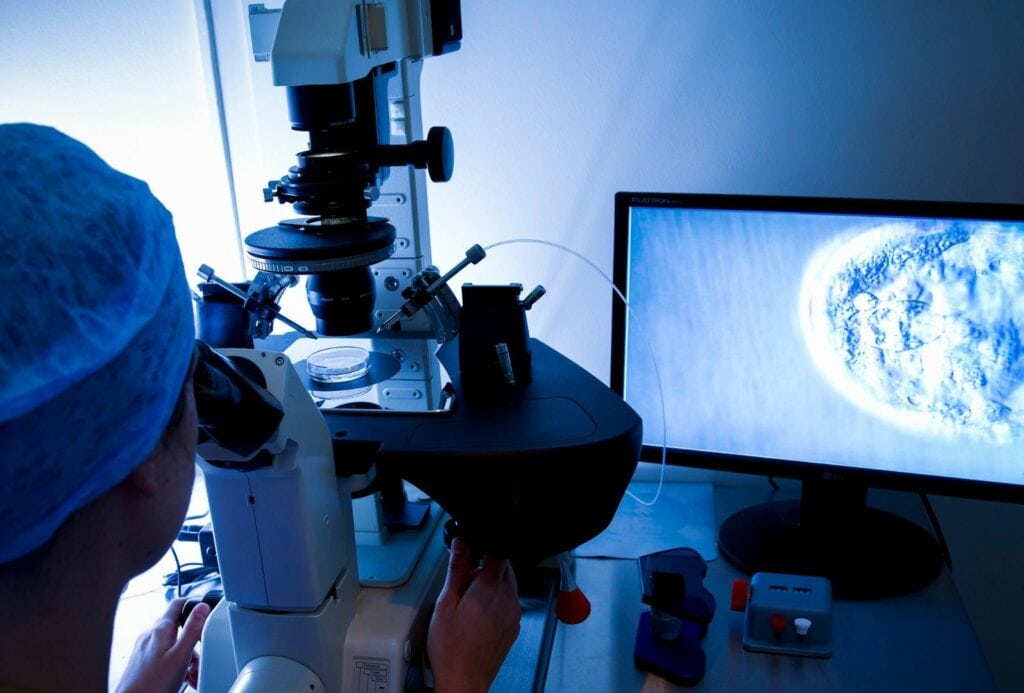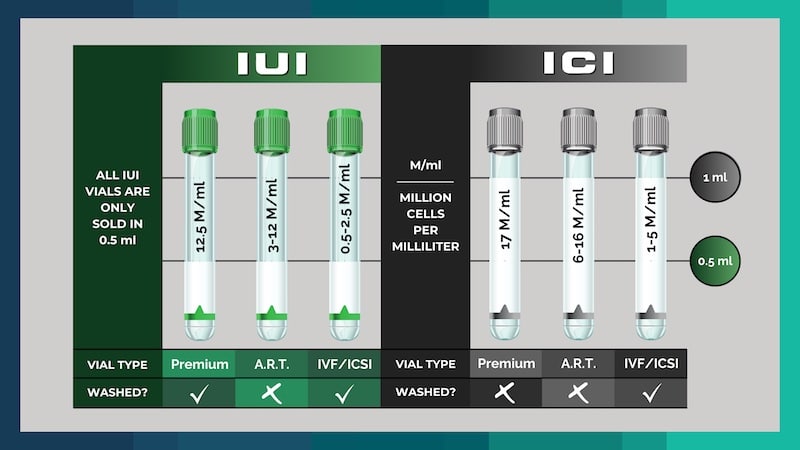What is CMV?
CMV, cytomegalovirus, is a member of the herpesvirus family and is highly prevalent worldwide. You can become infected with CMV through bodily fluids, including saliva, urine, blood, seminal fluid, and breast milk. The most common transmission modes are through close contact with infected individuals or exposure to bodily fluids. It is important to note that CMV can be present in an individual's body without causing any symptoms or illness, making detecting and preventing transmission challenging.

How Common is CMV?
The CDC states that nearly 1 in 3 children have already been infected with CMV by age 5, and by the age of 40, over half of the population is infected. The prevalence of CMV in sperm donors varies depending on the screened population. Studies have shown that CMV infection rates among sperm donors range from 30% to 70%. However, it is essential to note that the presence of CMV does not necessarily indicate active infection or the potential for transmission. Donor screening protocols typically include testing for CMV antibodies, which can help determine if the donor has contacted the virus in the past.
Symptoms of CMV Infection
CMV infection can manifest differently in individuals depending on their immune system and overall health. Many people infected with CMV may not experience symptoms or only have mild symptoms that resolve independently. However, those with weakened immune systems, such as individuals with HIV/AIDS or undergoing organ transplantation, may develop severe complications. These can include pneumonia, hepatitis, retinitis (inflammation of the retina), and neurological disorders. Awareness of these symptoms and seeking medical attention if necessary is crucial.
Becoming Infected With CMV
Primary CMV infection occurs in people who have never been exposed to the CMV virus before. Once a person becomes infected with CMV, the virus remains alive but dormant inside their body for the rest of their life. Recurrent CMV infection is when a dormant virus becomes active again. CMV infection is usually harmless and rarely causes illness. However, primary CMV infection can cause more severe problems for pregnant women than recurrent CMV infection.

Cytomegalovirus
CMV in human cells.
Diagnosis and Treatment of CMV Infection
Diagnosing CMV infection involves various methods, including blood tests to detect the presence of CMV antibodies or viral DNA. Other tests like urine or saliva samples may also confirm active infection. Treatment options for CMV infection depend on the severity of symptoms and the individual's immune status. A healthcare provider may prescribe antiviral medications to manage the condition and reduce the risk of complications.
Prevention of CMV Transmission in Sperm Donation
Preventing CMV transmission in sperm donation involves following proper protocols and procedures. Donor screening for CMV antibodies is essential in identifying potential donors who may pose a higher risk of transmission. Additionally, implementing strict guidelines for handling and processing donated sperm can help minimize the risk of contamination. Cryopreservation techniques, such as freezing and quarantine periods, can also be employed to ensure that donated sperm is free from infectious agents before use.
CMV Protocols At Cryobank America
The FDA requires CMV testing on all men who intend to donate sperm. A positive result, however, doesn't necessarily mean that a man will be ineligible to donate. Cryobank America will obtain semen samples from potential donors and then quarantine those specimens for at least six months. During that time, the donor may have had CMV antibody levels tested several times. If the antibody tests indicate the possibility of a CMV infection close to the time of the sperm donation, the donor will not be allowed to donate their specimens. If the testing demonstrates inconclusive results, the donor will not be permitted to donate. However, if a donor tests positive for CMV IgG only, indicating a past infection, he will be eligible to contribute. These samples appear in the Cryobank America donor database as CMV-positive.
Can Washed Donor Sperm Transmit CMV?
No, clinically washed sperm is typically free from CMV (Cytomegalovirus) transmission. The sperm-washing process separates sperm from the seminal fluid, which reduces the risk of transmitting infections such as CMV. However, no medical procedure can guarantee 100% elimination of all viruses or infections. You should always consult a healthcare professional for personalized advice and information.
Considering Pregnancy Through Donor Sperm?
Women considering pregnancy with donor sperm should have CMV antibody testing as part of their IDT. Those with a past infection are at low risk of transmitting CMV infection to a fetus and are at little to no risk if they decide to use a CMV-positive donor.
Women never exposed to CMV should consider using a CMV-negative donor. Even though the risk from a CMV-positive donor is low, it is impossible to determine whether there will be a risk for infection.
Cryobank America's donor catalog has a CMV search filter for positive and negative sperm donors. To find a CMV-negative sperm donor, select negative under the CMV option!
CMV Resources
For additional information on CMV, this link is especially helpful:
https://www.mayoclinic.org/diseases-conditions/cmv/symptoms-causes/syc-20355358
If you have any questions about CMV, please email us at [email protected] or call 817-945-8708; we will be happy to help!
How To Prepare For At-Home Insemination Before Placing Your Vial Order
At-home insemination is a method of assisted reproduction that allows couples to conceive without medical intervention. It involves using donor sperm to inseminate the female partner at home. You can use any of our vial options for at-home insemination. However, our premium IUI and ICI vials are recommended over all other options, which you can learn more about by clicking here.
One of the main benefits of at-home insemination is the privacy and convenience it offers. Couples can avoid the stress and expense of fertility clinics and have more control over the process. Whether you are purchasing donor sperm for at-home insemination or to have a procedure performed at your fertility clinic, our Clinic Release Form must be signed and submitted to us before you can complete your online purchase.
First Steps in Preparing for At-Home Insemination
Health & Wellness Check
Before placing your vial order with Cryobank America, ensuring both partners are in good health and have undergone necessary medical check-ups and testing is essential. This assurance includes checking for any underlying medical conditions affecting fertility and testing for sexually transmitted infections. It is also advisable to consult with a healthcare professional to ensure that at-home insemination is a safe and appropriate option for you.

Timing is Everything: Effectively Tracking Your Ovulation Before Scheduling Your Vial Delivery
Understanding ovulation and fertility is crucial for maximizing the chances of conception through at-home insemination. You must plan your vial delivery just before your fertility window.
Several methods are available for tracking ovulation, including tracking basal body temperature, monitoring cervical mucus, using ovulation predictor kits, or tracking changes in the cervix. Each method has advantages and considerations, so trying different ways to find the one that works best for you may be helpful.
Timing insemination correctly is crucial for increasing the chances of conception. That's why we don't consider ovulation-tracking mobile apps to be a reliable method. These mobile applications can only provide a vague approximate fertility window. Use ovulation testing kits designed to track ovulation precisely and provide detailed instructions. Typically, these kits will include testing strips that monitor the presence and concentration of luteinizing hormone (LH) in your urine, which appears about 12 – 36 hours before ovulation. Insemination should occur within a day or two before ovulation or on the day of ovulation itself. Perfectly timing insemination ensures that the sperm is present in the reproductive tract when the egg is released, increasing the chances of fertilization.
I Ordered Donor Sperm, and My Vials Are Out for Delivery. What's Next?
Once you've purchased your vials from Cryobank America and our team has coordinated an excellent delivery time based on your schedule, you will receive a USPS tracking code. Your tracking code will tell you the exact date and approximate delivery time.
Once your delivery arrives, you'll receive your vials along with our at-home insemination kit. Our kit includes a pre-charged dry shipper containing your purchased vials, complete documentation, and a sterile syringe.
Our dry shippers are pre-charged in our laboratory to remain active during shipping. They transport biological specimens safely and hold cryogenic temperatures of -150°C or colder. Our dry shippers are manufactured with compounds that absorb liquid nitrogen, ensuring there won't be any spills during shipping. Each dry shipper ships inside a protective container to provide an additional layer of protection.
Your At-Home Insemination Kit
Your delivery will also include four valuable pieces of documentation consisting of the following:
- A package summary. Your summary will list what you ordered, including the vial type, quantity, and total cost for your purchase. It will also include an analysis of your vial's motility and sperm count.
- Infectious Disease Report. This information includes your selected donor's most recent lab testing and infectious/non-infectious disease reports.
- Complete instructions. This paperwork will guide you on handling your dry shipper, thawing your specimen, and performing insertion.
- Package return slip. We will also provide a return slip for your dry shipper.
Lastly, you will receive a ready-for-use sterile syringe. Remember, you have seven days from the shipment date to complete the insertion. If shipping your vials and accompanying equipment takes two days, you will have five days to perform at-home insemination.
Tips for Successful At-Home Insemination
Creating a comfortable and safe environment is very important during insemination. Make sure your space is clean and free from distractions. It may be helpful to create a relaxing atmosphere by playing soothing music or using aromatherapy.
Experts recommend lying flat or with your hips elevated for 25-30 minutes following gentle insertion. You can inseminate once if you're confident in your fertility window calculation. If unsure, consider inseminating twice.
Climaxing through clitoral stimulation can also increase your chances of conception. When a woman climaxes, her cervix becomes more receptive to sperm.
Refrain from strenuous exercise for a few days following insemination and continue to eat healthy. Eliminate processed foods with a high list of ingredients and stick to whole foods as long as possible. Avoid foods that are hard to digest, such as red meats, greasy foods, and refined sugar. Drinking alcohol or using tobacco products isn't recommended during your insemination, as they harm egg quality and fertility.
How We Can Help You Through Your Journey
Our assistance doesn't stop at shipping your vials! If you have any questions before, during, or after you've initiated your insemination, don't hesitate to pick up the phone. We've helped many individuals and couples who have embarked on this journey already, and we look forward to applying our expertise and genuine care to help make everything as easy and stress-free as possible.
- Protecting Your Health: Choosing A Sperm Bank Over Natural Insemination
- Hatching a Plan: Learning The Basics About Assisted Hatching in IVF
- Navigating GYN Surgery Before Artificial Insemination
- PGT Testing and Its Role in IVF Treatment
- The Ultimate Guide To Where You Can Donate Sperm In All 50 States
What is In Vitro Fertilization?
In vitro fertilization (IVF) is a fertility treatment that has helped millions of couples worldwide conceive and start families. It involves a complex process of fertilizing eggs outside the body and transferring them to the uterus. While IVF has become increasingly common, it is vital to understand the science behind it to make informed decisions about fertility treatments.
Understanding the Basics of IVF Fertility Treatments
IVF is a fertility treatment that involves fertilizing eggs outside the body and transferring them to the uterus. It is used when other fertility treatments have failed, or underlying medical conditions make it difficult to conceive naturally. The process involves several steps, including hormone therapy to stimulate egg production, retrieval, fertilization, and embryo transfer.
Not everyone is a candidate for IVF, and it is essential to consult with a fertility specialist to determine if it is the right option for you. Factors such as age, medical history, and overall health can all impact the success of IVF.
The Role of Hormones in IVF Fertility Treatments
There are several types of hormones used in hormone therapy for IVF fertility. These include follicle-stimulating hormone (FSH), luteinizing hormone (LH), human chorionic gonadotropin (hCG), and gonadotropin-releasing hormone (GnRH). FSH and LH are used to stimulate the ovaries to produce multiple eggs. hCG is used to trigger ovulation, which is necessary for egg retrieval. GnRH is used to prevent premature ovulation.
Hormone therapy is typically administered over several weeks leading up to egg retrieval. Your fertility specialist should carefully monitor the timing and dosage of the medications to ensure that the ovaries are responding appropriately and that ovulation occurs at the optimal time for egg retrieval.
The Process of Egg Retrieval in IVF Fertility Treatments
Egg retrieval is a critical step in the IVF process, as it involves removing mature eggs from the ovaries for fertilization. The procedure typically involves using ultrasound guidance to locate the follicles containing mature eggs, then using a needle to extract them.
While egg retrieval is generally safe, it can have risks such as bleeding, infection, and damage to surrounding organs. Timing is also important in egg retrieval, as eggs must be retrieved at the right time to maximize their chances of fertilization.

The Importance of Sperm Quality in IVF Fertility Treatments
Sperm quality is crucial in IVF, as healthy sperm are necessary for successful fertilization. Factors such as age, lifestyle habits, and underlying medical conditions can all impact sperm quality.
Techniques such as intracytoplasmic sperm injection (ICSI) may be used to improve sperm quality and increase the chances of fertilization. ICSI involves injecting a single sperm directly into an egg, bypassing any potential issues with sperm motility or morphology.
The ICSI procedure involves several steps. First, the eggs are retrieved from the woman's ovaries using ultrasound-guided aspiration. The eggs are then placed in a culture dish and prepared for injection.
Next, a single sperm is selected and immobilized using a microneedle. The needle is then used to inject the sperm directly into the egg's cytoplasm. After injection, the eggs are monitored for signs of fertilization.
The Role of Embryo Development in IVF Fertility Treatments
Embryo development is critical to IVF, as healthy embryos are necessary for a successful pregnancy. Following fertilization, the embryo undergoes a series of cell divisions, progressing from two to four cells. By the fifth or sixth day, the embryo reaches the blastocyst stage, marking the optimal time for transfer into the uterus.
Advancements in IVF technology have led to improved patient success rates and outcomes. For example, preimplantation genetic testing (PGT) can help identify congenital abnormalities in embryos before they are transferred into the uterus.
Other possibilities for improving embryo development and implantation include using artificial intelligence (AI) to analyze embryo images and predict which embryos will most likely result in successful pregnancies.
The Emotional and Psychological Impact of IVF Fertility Treatments
IVF can have a significant emotional and psychological impact on patients and their partners. Common challenges include stress, anxiety, and depression. Coping strategies such as therapy or support groups can help manage these challenges.
IVF Fertility Treatments
Research and development in IVF technology continue to advance, with potential innovations such as artificial intelligence and gene editing on the horizon.
IVF fertility treatments have helped millions of couples worldwide conceive and start families. Understanding the science behind IVF is crucial for making informed decisions about fertility treatments.
- Protecting Your Health: Choosing A Sperm Bank Over Natural Insemination
- Hatching a Plan: Learning The Basics About Assisted Hatching in IVF
- Navigating GYN Surgery Before Artificial Insemination
- PGT Testing and Its Role in IVF Treatment
- The Ultimate Guide To Where You Can Donate Sperm In All 50 States
The Average Success Rate for Artificial Insemination
Artificial insemination (AI) is a fertility treatment that involves placing sperm directly into a woman's reproductive system to increase the chances of pregnancy. It is a popular option for couples struggling with infertility or for same-sex couples who wish to conceive. The average success rate for artificial insemination ranges between 5% to 30% per cycle, and success can depend on several factors. Understanding these factors is crucial for making informed decisions about your fertility treatments.
Factors Affecting the Success Rate For Artificial Insemination
Several factors can affect the success rate of artificial insemination, including sperm quality, timing, age, and fertility drugs.
What's the most important factor? You guessed it; it's sperm quality! Healthy sperm is necessary for fertilization, and poor sperm quality can significantly reduce the chances of pregnancy. Timing is also crucial, as insemination must occur during the woman's fertile window. Age is another factor affecting success rates, as fertility declines with age. Fertility drugs are often used to stimulate ovulation and increase the chances of pregnancy. Finally, the selected method for artificial insemination can impact the outcome for success.
Understanding the Role of Sperm Quality in the Success Rate For Artificial Insemination
Sperm quality refers to the ability of sperm to fertilize an egg and produce a viable pregnancy. Various factors such as sperm count, motility, morphology, and DNA integrity determine the overall quality. High-quality sperm is essential for achieving successful pregnancies through artificial insemination. Poor sperm quality can lead to low fertility rates, reduced conception rates, and increased risk of embryonic loss.
The impact of poor sperm quality on fertility rates cannot be overstated. Women who inseminate with low-quality sperm can result in failed pregnancies or offspring with genetic abnormalities. Therefore, it is crucial to ensure that you are receiving high-quality sperm for your artificial insemination procedure.
Several factors can affect sperm quality, including environmental and genetic factors. Environmental factors such as temperature, nutrition, and stress can significantly impact sperm quality. High temperatures can damage sperm cells, while poor nutrition can lead to reduced sperm production and motility. Stress can also affect sperm quality by decreasing testosterone levels and increasing oxidative stress.
Genetic factors also play a crucial role in determining sperm quality. That's why we only accept high-quality applicants with desirable traits to improve the overall genetic quality of offspring produced through artificial insemination.
At Cryobank America, we offer premium-grade IUI vials. IUI vials are a great choice because they include sperm that has undergone a density gradient separation wash. This method purifies and isolates the healthiest cells, removing biological debris and seminal fluid, ultimately increasing your success rate. Click here to learn more about our vial types. Click here to view vial pricing.

The Importance of Timing in Artificial Insemination
Timing is crucial in achieving pregnancy through artificial insemination. The window of opportunity for successful insemination is relatively small, and missing it can significantly reduce the chances of conception. Sperm can survive in the female reproductive system for up to five days, but the egg is only viable for 12-24 hours after ovulation. Therefore, it is essential to time the introduction of sperm correctly to coincide with ovulation.
The timing of insemination can also affect the quality of sperm that reaches the egg. Sperm inside of the female reproductive system for too long may become less motile and less capable of fertilizing an egg. On the other hand, introducing sperm too early can result in a lower concentration of sperm, reducing the chances of successful fertilization.
Understanding the menstrual cycle and its phases is crucial to achieving successful insemination. The menstrual cycle is divided into three phases: follicular, ovulatory, and luteal. The follicular phase begins on the first day of menstruation and lasts until ovulation. During this phase, follicles in the ovaries mature and prepare to release an egg.
The ovulatory phase is when ovulation occurs, and an egg is released from the ovary. This phase typically lasts 24 hours but can extend up to 48 hours. Finally, during the luteal phase, the body prepares for pregnancy by thickening the uterine lining.
The timing of insemination is critical during the ovulatory phase since the egg is released from the ovary and travels down the fallopian tube. Therefore, tracking menstrual cycles can help determine when ovulation occurs and increase the chances of successful insemination.
The Impact of Age on the Success Rate For Artificial Insemination
The biological clock refers to the natural decline in fertility that occurs as women age. As women age, their eggs become less viable, and the chances of conceiving naturally or through fertility treatments decrease. This decline in fertility is due to a decrease in the number and quality of eggs available for fertilization.
Age also impacts the success rates of artificial insemination. Studies have shown that women over 35 have lower success rates with artificial insemination than younger women. Older women have fewer viable eggs and are more likely to have underlying fertility issues that can impact the success of the treatment.
Studies have shown that women under 35 have success rates of around 20% per cycle with artificial insemination; however, this success rate decreases as women age. Women over 35 have success rates of approximately 10% per cycle, and women over 40 have success rates of around 5% per cycle. Women are born with a finite number of eggs, and as they age, the number and quality of these eggs decline. When a woman reaches her mid-30s, her fertility begins to fall rapidly.
Other age-related factors impacting success rates include underlying fertility issues, such as endometriosis or polycystic ovary syndrome (PCOS), and lifestyle factors, such as smoking or obesity.
The Role of Fertility Drugs in Artificial Insemination
Fertility drugs are often used in conjunction with artificial insemination to increase the chances of pregnancy. These drugs work by stimulating ovulation and increasing the number of eggs available for fertilization.
Several fertility drugs are available, including Clomifene citrate (Clomid), Metformin, and Gonadotropins. These drugs can significantly increase the chances of pregnancy when used correctly.
Tips for Maximizing the Success of Artificial Insemination
Several lifestyle changes can help maximize the success rate of artificial insemination, including maintaining a healthy weight, reducing stress levels, and avoiding smoking and excessive alcohol consumption.
Choosing the proper fertility treatment and clinic is imperative for the best outcome. Preparing for the procedure by carefully following all instructions can also increase the chances of pregnancy. Finally, post-insemination care is crucial for ensuring a healthy pregnancy.
Advances in AI technology are continually improving success rates and making personalized treatments more accessible than ever. Understanding success rates is crucial for making informed decisions about fertility treatments and achieving a successful pregnancy.
- Protecting Your Health: Choosing A Sperm Bank Over Natural Insemination
- Hatching a Plan: Learning The Basics About Assisted Hatching in IVF
- Navigating GYN Surgery Before Artificial Insemination
- PGT Testing and Its Role in IVF Treatment
- The Ultimate Guide To Where You Can Donate Sperm In All 50 States

Different Vial Types:
If you have been curious about using sperm donors to help start your family, you may have looked at the prices of vials and noticed several different types available. What is an IUI, ICI, A.R.T., and IVF vial? This blog will let you know the differences between each one so that it can guide you in figuring out which vial is best for you.
IUI Premium Vials
IUI (Intrauterine insemination) vials undergo a "washing" procedure utilizing gradient separation methods, resulting in only the sperm and stabilizing media, making it safe for the uterus.
At Cryobank America, we guarantee 25 Million cells per milliliter (25M/ml). Each IUI vial is sold in a half-milliliter (0.5ml) unit, giving you 12.5M/ml of motile sperm cells per premium IUI vial. IUI specimens can be safely placed directly into the uterus by your treating physician because there are no "round" cells or other "junk" in them that causes cramping. These units are also ideal for at-home inseminations, where they'll be placed near the top of the vagina and cervix.
ICI Premium Vials
ICI (intracervical insemination) vials are considered "unwashed" since they have not undergone gradient separation steps, which remove the non-motile sperm cells, round cells, and other junk found in the ejaculate.
At Cryobank America, we guarantee 17 Million cells per milliliter (17M/ml). Each vial sold comprises one milliliter (1ml). ICI units are typically used for at-home insemination since these specimens cannot be placed into the uterus due to severe cramping. Some fertility clinics prefer to wash their patient's specimens in-house (usually at an additional cost to the patient); therefore, these units contain one milliliter of a specimen compared to IUI units, which are sold in half milliliter units (0.5ml). We recommend our clients purchase IUI units since they can work for both in-clinic procedures and at-home inseminations and have the highest concentration of motile sperm cells, increasing the chances of successful insemination.
IUI A.R.T. & ICI A.R.T.
A.R.T., or artificial reproductive technology, vials are lower quantity units. At Cryobank America, we guarantee 3-12 Million per half a milliliter (and 6-24 M/ml) for IUI ART and 6-16 M/ml for ICI ART units. These vials cost less since they contain fewer progressively motile sperm cells.
IUI/IVF & ICI/IVF (For IVF/ICSI)
Lastly, our IUI/IVF undergoes our wash process and is guaranteed at 0.5-2.5 Million per half (0.5) milliliter (1-5 M/ml). Our ICI/IVF vials are unwashed, guaranteeing 1-5 Million per (1) milliliter. We recommend these units for clients utilizing in-vitro fertilization or Intracytoplasmic Sperm Injection (ICSI) procedures, where only a few sperm are needed.
If you still have questions concerning vial types and differences between the classes, don't hesitate to contact one of our friendly and knowledgeable Cryobank America staff members today!
Please email us at [email protected] or give us a call at 817-945-8708
All pricing can be found at https://cryobankamerica.com/pricing/

